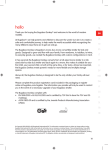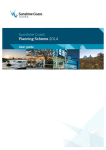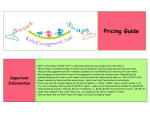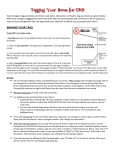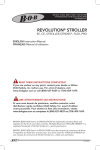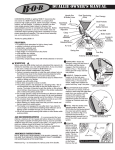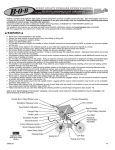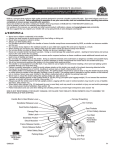Download Römer BOB Revolution SE
Transcript
® BOB Gear by Britax (03) 9288-7288 99 Derby Road, Sunshine, Victoria 3020 www.britax.com.au REVOLUTION STROLLER SE, CE and STROLLER STRIDES ENGLISH Owner’s Instruction Manual TAKE TIME READ AND UNDERSTAND THESE INSTRUCTIONS COMPLETELY! Before attempting to assemble or use your new stroller, read and understand these assembly and use instructions completely, as well as the warnings at the beginning and throughout this document, to ensure proper assembly and operation. If you are unclear on any point, contact BRITAX CUSTOMER SERVICE 1300 303 330 For more information, please visit www.britax.com.au OMB15 WARNINGS FAILURE TO FOLLOW THESE WARNINGS AND ASSEMBLY INSTRUCTIONS COULD RESULT IN SERIOUS INJURY OR DEATH. Retain for future reference. Read all instructions carefully before assembly and use of this stroller. Always follow the instructions. the correct use and maintenance of this product is essential. Follow the manufacturers instructions. • Please save owner’s manual for future use and reference. • For safe operation, all users must read and understand instructions and warnings completely before use. • Never leave child unattended in the stroller. Always keep child in view while in stroller. • Avoid serious injury from falling or sliding out. Secure the child in the harness at all times. USE THE HARNESS AT ALL TIMES. Ensure your child is secured with a correctly adjusted safety harness. • Never allow occupant to stand in stroller. Stroller can tip over. • Use the tether strap to prevent the stroller from rolling away. • Do not carry extra children or bags on this stroller. Do not attach parcels or bags to the handlebar or frame of stroller except those recommended by BOB, as stroller can become unstable and tip over. • Do not place sharp objects in the seat back pocket. Leaning against sharp objects in seat back pocket can result in injury to occupant. • When starting out and during use, always make sure the child’s hands and feet are away from wheels and any moving parts. • Never let go of the stroller when parked on an incline because it may slide or tip over. Always park on a flat surface. • Remove the child from the stroller before going up or down stairs or escalators. • Never use with low tire pressure or deflated tires as this could result in loss of control. • Never pull stroller backward up stairs. Doing so could damage the suspension system, leading to frame failure. • Use extreme caution when using stroller on uneven and/or unpaved, wet or slick surfaces, as these conditions create additional hazards and can lead to a loss of stability. • Do not modify the stroller or any labels. Doing so voids the warranty and could lead to a dangerous condition. • Protect stroller when transporting or shipping to prevent damage to stroller and stroller components. Check closely for damage after transporting or shipping. • Discontinue using stroller if damaged or if any parts are missing. • Do not wear roller skates or inline skates while pushing stroller. • Care must be taken when folding and unfolding the stroller to prevent finger entrapment or injury. • To avoid injuries, never fold or unfold stroller with other individuals within reach of stroller. • The stroller is not equipped for use in low light or after dark. • Failure to properly assemble or install the quick release wheels on this stroller may result in the wheels becoming detached while moving and a subsequent loss of control. • Never jog with the stroller in walk mode because doing so could result in loss of control. • The parking brake is not designed as a stopping brake. The brake should not be used to slow or stop the stroller because doing so could cause the stroller to stop abruptly, resulting in loss of control. • Do not park on inclines. The parking brake is intended to park the stroller on flat surfaces only. Parking on inclines may result in tip over or runaway stroller. 2 OMB15 • Never leave child in the stroller unattended with or without the parking brake set. • Never load or unload the stroller without the parking brake set. • The maximum weight capacity of the stroller is 25 kgs (occupant plus luggage weight). Do not exceed the maximum weight, as stroller will become unstable. • Always jog with the stroller seat in the fully upright position. Jogging with the seat in reclined positions may result in a loss of stability. • When seat is fully reclined, backward tip over is more likely. • When not in use disconnect shoulder straps from the waist strap and buckle to prevent strangulation. • Check that all safety locks are engaged before placing a child in the stroller. • To prevent the risk of the stroller catching fire, do not park it near an exposed heat source as radiator, an open fire or barbeque, etc. • Always raise the leg support (where fitted) to its highest position when transporting a baby. This will reduce the risk of the baby falling out through the front of the stroller. • It is unsafe to use accessories other than those tested and approved by BOB. For maximum safety only use accessories designed for this stroller. SAFETY WARNING • The sun is very strong. DO NOT LEAVE YOUR CHILD EXPOSED TO THE SUN. The canopy or hood on this product will not give your child total protection from the harmful rays of the sun. IMPORTANT • The upright positions are not suitable for use with children less than 6 months old. The lowest recline position should be used to transport babies, the backrest can be adjusted to more upright position as the child grows older and is able to support its head without assistance. 3 OMB15 TABLE OF CONTENTS WARNINGS Page 2 TABLE OF CONTENTS Page 4 STROLLER ANATOMY Page 5 AGE RECOMMENDATIONS Page 6 STROLLER ASSEMBLY Page 6 Unpack Stroller Page 6 Wheels Page 6 Adjust Quick Release Page 7 Rear Wheel Installation Page 7 Removing Rear Wheel Page 8 Front Wheel Secondary Retention Devices Page 9 Front Wheel Installation Page 9 Removing Front Wheel Page 10 Unfold Stroller Page 11 Fold Stroller Page 11 STROLLER ADJUSTMENTS Page 12 Choose Walk or Jog Mode Page 12 Check Tire Pressure Page 12 Adjust Tracking Page 13 Fine Tune Tracking Page 13 Select Shock Setting Page 14 Setting Parking Brake Page 14 Secure Child In Seat Page 15 Attach Wrist Strap Page 16 Recline Seat Page 16 Position Canopy Page 17 Accessory Adapter Page 17 CARE AND MAINTENANCE Page 18 STORAGE Page 18 CARGO Page 18 STROLLER ACCESSORIES Page 18 BOB IS NOT RESPONSIBLE FOR INJURY, DEATH, DAMAGE OR FAILURE THAT RESULTS FROM OWNER’S FAULTY ASSEMBLY, USE OR MAINTENANCE. 4 OMB15 STROLLER ANATOMY REVOLUTION STROLLER SE, CE and STROLLER STRIDES Handlebar Canopy Handlebar Release Lever Accessory Adapter Seat Harness Shock Release Knob Swivel Knob Swing Arm Tracking Knob Quick Release Lever Low Boy Cargo Basket CONGRATULATIONS Congratulations on your purchase of the BOB® Revolution® SE, Revolution CE or Stroller Strides®® Fitness Stroller. For updates to this manual, warranty and other recent product notifications, please visit www. britax.com.au periodically or any time before making approved changes or adding approved equipment to your stroller. BOB recommends that you register your stroller at www. britax.com.au/register. This will allow us to notify you directly if there are any updates concerning the use of the stroller. Wrist Strap Seat Back Pocket Frame Release Handle Parking Brake Quick Release Lever 5 OMB15 AGE RECOMMENDATIONS BOB recommends that your child should be at least 8 weeks old before riding in a BOB stroller without a BOB Infant Car Seat Adapter and compatible infant car seat. Please note that babies incapable of holding their head up must have additional head and neck support to ride safely and comfortably. For jogging or offroad stroller use, children should be at least 8 months old. With the addition of the BOB Infant Car Seat Adapter and compatible infant car seat, newborns may be able to ride in the stroller. Children develop at different rates. Prior to first use, consult with your pediatrician regarding suitability of stroller use with your child. Please refer to the below table for age/use guidelines: RECOMMENDED USE AGE Infant Car Seat Adapter (Walk Only) 0 - 8 Weeks See BOB Infant Car Seat Adapter Manual for maximum occupant weight. Walk Only 8 Weeks - 8 Months Jogging/Off-Road 8 Months - 5 Years STROLLER ASSEMBLY UNPACK STROLLER Remove stroller and wheels from box. Front wheel is stowed in folded stroller. Remove all packaging materials and discard to avoid choking and suffocation hazards. WHEELS Before attempting to install wheels, read and understand warnings and instructions completely. Using your stroller with an improperly adjusted wheel quick release can allow the wheel to vibrate, wobble or become detached from the stroller. This can result in serious injury or death. Accordingly, it is critical that you: • Ask your dealer to instruct you on the proper technique for safely installing and removing your wheels. • Understand and use the proper method for securely clamping a wheel to the stroller using a quick release. • Check to make sure the wheels are securely clamped before each use of the stroller. The wheel quick release is a cam device that supplies the clamping force required to hold the stroller wheel securely in place. To safely secure a wheel to the stroller, it is critical that you understand how the quick release works, how to use and adjust it properly and the amount of force necessary to safely secure the wheel. The quick release is a cam device and must be used correctly to supply the necessary clamping force to safely hold the wheel in place. It is not a wing nut system and turning the lever while holding the tension adjusting nut does not supply the required force to safely clamp the wheel in the dropouts. 6 OMB15 ADJUST QUICK RELEASE The rear wheels are correctly clamped in place by the force generated when the quick release lever is closed and the cam action pulls the axle against the dropout, securing it in place. The front wheel is correctly clamped in place by the force generated when the quick release lever is closed and the cam action pulls the lever housing against one dropout, and pulls the adjusting nut against the other dropout, clamping the hub between the dropouts. The tension adjusting nut sets the amount of clamping force. Turning the tension adjusting nut in the clockwise direction while preventing the quick release lever from rotating, increases the amount of clamping force. Alternatively, turning the tension adjusting nut counterclockwise, while preventing the quick release lever from rotating, reduces the amount of clamping force. The tension adjusting nut only needs minor adjustments to provide the correct clamping force, less than a half turn can mean the difference between safe and unsafe clamping force. REAR WHEEL INSTALLATION 1. Unlock Parking Brake Prior to installing the rear wheels, position the parking brake in the unlocked position. 2. Rotate Quick Release Lever Rotate the quick release lever so it curves away from the dropout. Tension Adjusting Nut Quick Release Lever 3. Insert Rear Wheel Stub Axle Insert the rear wheel’s stub axle into the hole in the rear dropout. If the axle does not slide in easily, loosen the quick release tension adjusting nut by hand. Re-insert the axle fully into the rear dropout until the axle shoulder or snap ring on the axle comes in contact with the dropout. Stub Axle Dropout 4. Adjust Quick Release Cam Lever To adjust the quick release, hold the quick release cam lever in the FULLY OPEN position with your right hand, and tighten the tension adjusting nut with your left hand until it is finger tight against the dropout. 7 OMB15 To TIGHTEN tension adjusting nut, turn clockwise. FULLY CLOSED If the quick release lever cannot be rotated to the FULLY CLOSED position, rotate the lever to the FULLY OPEN position and turn the tension adjusting nut a quarter turn counterclockwise. Repeat the closing process. To LOOSEN tension adjusting nut, turn counterclockwise. To properly close the quick release and secure the rear wheel in the dropouts, confirm the axle is fully inserted in the dropout, while maintaining the wheel in this position, rotate the quick release toward stroller and into the FULLY CLOSED position. When properly closed, the curve of the quick release will be pointing toward the dropout and angled slightly toward the center of the stroller. To generate enough clamping force it is necessary to wrap your fingers around the dropout while closing the quick release lever. The proper force required to close the quick release lever should leave a visible imprint in the palm of your hand. FULLY CLOSED REMOVING REAR WHEEL 1. Unlock Parking Brake Prior to removing the rear wheels, position the parking brake in the unlocked position. 2. Open Quick Release Lever Move the wheel’s quick release lever from the locked or FULLY CLOSED position to the FULLY OPEN position. FULLY CLOSED It takes considerable force to securely clamp the wheel. If you are able to completely close the quick release without wrapping your fingers around the dropout and the quick release lever does not leave a visible imprint in the palm of your hand, the tension is not adequate. Rotate the lever to the FULLY OPEN position and turn the tension adjusting nut a quarter turn clockwise and repeat the closing process. FULLY OPEN 3. Remove Wheel Raise the wheel a few inches off the ground and pull the wheel out of the dropout. 8 OMB15 RETENTION DEVICES Your stroller fork utilizes secondary wheel retention devices designed to help keep the wheel from disengaging from the fork if the quick release is incorrectly adjusted and tightened. The wheel can still remain loose and wobbly even with the secondary retention device working if the quick release has not been properly tightened and adjusted. The secondary retention devices are backup systems and are not intended as a substitute for a properly adjusted quick release. The secondary retention devices on your stroller are the integral type that are formed into the outer faces of the fork dropouts. Using your stroller with an improperly adjusted and tightened wheel quick release can allow the wheel to vibrate, wobble or become detached from the stroller. This can result in serious injury or death. FRONT WHEEL INSTALLATION 1. Rotate Quick Release Lever Rotate quick release lever so that it curves away from the wheel. This places it in the FULLY OPEN position. Quick Release Lever FULLY OPEN FULLY CLOSED O P EN FRONT WHEEL SECONDARY 2. Insert Front Wheel When facing the front of the stroller, insert the wheel between the fork dropouts so that the axle firmly contacts the top of the slots of the fork dropouts. Dropouts (Secondary Retention Devices) The secondary retention devices serve as a backup for a critical adjustment. The secondary retention devices can reduce the risk of the wheel disengaging from the fork if the quick release is not adjusted and tightened correctly. Secondary retention devices are not a substitute for correct quick release adjustment and tightening. Dropout 3. Adjust Quick Release Lever To adjust the quick release, hold the quick release cam lever in the FULLY OPEN position with your right hand as shown. Tighten the tension adjusting nut with your left hand until it is finger tight against the fork dropout. 9 OMB15 Rotate the lever to the FULLY OPEN position and turn the tension adjusting nut a quarter turn clockwise and repeat the closing process. Tension Adjusting Nut Quick Release Lever 4. Close Quick Release Lever To properly close the quick release and secure the front wheel in the dropouts, confirm the axle is contacting the top of the dropouts on both sides and the wheel is centered left to right. Fork Blade If the quick release lever cannot be rotated to the FULLY CLOSED position, rotate the lever to the FULLY OPEN position and turn the tension adjusting nut a quarter turn counterclockwise. Repeat the closing process. REMOVING FRONT WHEEL FULLY CLOSED Dropouts FULLY OPEN While maintaining the wheel in this position, rotate the quick release upward and into the FULLY CLOSED position. When properly closed, the curve of the quick release will be pointing toward the wheel and parallel to the fork blade. To generate enough clamping force it is necessary to wrap your fingers around the fork blade while closing the quick release lever. The proper force required to close the quick release lever should leave a visible imprint in the palm of your hand. It takes considerable force to securely clamp the wheel. If you are able to completely close the quick release without wrapping your fingers around the fork blade and the quick release lever does not leave a visible imprint in the palm of your hand, the tension is not adequate. 1. Open Quick Release Lever Move the wheel’s quick release lever from the locked or FULLY CLOSED position to the FULLY OPEN position. Your front fork has integral secondary retention devices that require loosening the tension adjusting nut enough to allow removal of the wheel. 2. Remove Front Wheel Raise the front wheel a few inches off the ground and tap the top of the wheel with the palm of your hand to knock the wheel out of the front fork. 10 OMB15 UNFOLD STROLLER Care must be taken when folding and unfolding the stroller to prevent finger entrapment or injury. SNAP To avoid injuries, never fold or unfold stroller with other individuals or children within reach of stroller. 1. Lift Red Frame Release Handle Keep tires on ground as stroller swing arm begins to swing open. FOLD STROLLER 1. Lock Parking Brake Set parking brake in locked position. 2. Remove Child From Seat 3. Empty Stroller Remove contents from low boy cargo basket and pockets. NOTE: Stroller swing arm will swing open and “snap” into an open and locked position. 4. Rotate Handlebar Squeeze both handlebar release levers simultaneously. Rotate handlebar forward onto seat. SNAP 2. Rotate Handlebar Lift handlebar up and back until it “snaps” into locked and upright position. 5. Lift Red Frame Release Handle Using a short, quick tug, lift red frame release handle up. Keep tires on ground as stroller collapses toward front wheel. 11 OMB15 STROLLER ADJUSTMENTS CHOOSE WALK OR JOG MODE If front fork is in “JOG MODE” front fork will be locked and the front fork/ wheel will not swivel left or right as it does in “WALK MODE”. Never jog with the stroller in walk mode. Doing so could result in loss of control and serious injury. WALK MODE (Walking) 6. Lay Stroller Flat Slide swivel knob up and to the left. Fork will now rotate 360 degrees. NOTE: Stroller is shipped with front wheel in walk mode. JOG MODE (Jogging/Off-Road) 7. Secure Folded Stroller Use wrist strap buckle to secure stroller in folded position. Slide swivel knob upward and to the right. Knob will slide into downward position. Rotate fork/wheel until it “snaps” into forward position. WALK MODE JOG MODE Handlebar SNAP CHECK TIRE PRESSURE 8. Make It Smaller Take off the front and rear wheels to make it even smaller. See Removing Rear Wheel and Removing Front Wheel sections. Plastic wheels are rated to a maximum tire inflation pressure of 30 pounds per square inch (psi) or 206.8 kilo pascal (kpa). The maximum inflation pressure is embossed on the wheel next to the valve stem. 12 OMB15 Inflating tires above 30 psi can damage the wheel and/ or tire resulting in loss of control and injury. Aluminum wheels can have the tires inflated to the pressure embossed on the tire. However, we recommend 30 psi for a comfortable ride. Inflating tires above the maximum inflation pressure embossed on the tire can damage rim and or tire resulting in loss of control and injury. 5 mtrs 5. Align Rear Wheel Axles Align stroller so rear wheel axles are perpendicular to a straight line. 6. Test Alignment Push stroller straight forward and release to see if stroller veers right or left. Repeat push test several times. ADJUST TRACKING If stroller pulls left or right when the front wheel is in jog mode and stroller is on flat terrain, adjust tracking as outlined in the following steps. Do not roll test with a child or any occupant in the stroller. 1. Empty Stroller Remove contents from low boy cargo basket and pockets. 2. Check Tire Pressure If stroller consistently pulls to left or right, proceed to Fine Tune Tracking. FINE TUNE TRACKING If Stroller Pulls LEFT If your stroller pulls LEFT, turn tracking knob counterclockwise up to one half turn. 3. Set Stroller to Jog Mode Slide swivel knob to right. Knob will slide into downward position. Rotate fork/wheel until it “snaps” into forward position. See Choose Walk or Jog Mode section. 4. Place Stroller On Level Ground Find a stretch of level ground about 5 meters. Tracking Knob 13 OMB15 If Stroller Pulls RIGHT If your stroller pulls RIGHT, turn tracking knob clockwise up to one half turn. Position 1: Child 18 kgs or less 18 kgs SNAP Position 2: Child 18 to 25 kgs 25 kgs Tracking Knob REPEAT roll test and adjust as needed until stroller rolls straight. SELECT SHOCK SETTING NOTE: Every time stroller is folded, stroller shocks default to 18 kgs position (Position 1). 1. Remove Child From Seat 2. Set Shock Setting To Position 2 Depress shock release knob and simultaneously pull toward back of stroller, sliding knob into position 2. Knob will “snap” into place when in correct position. REPEAT on opposite side. SNAP 18 kgs SETTING PARKING BRAKE The parking brake prevents the stroller from moving while loading and unloading. The parking brake is not designed as a stopping brake. The parking brake is not designed as a stopping brake. The brake should not be used to slow or stop the stroller because doing so could cause the stroller to stop abruptly, resulting in loss of control. Do not park on inclines. The parking brake is intended to park the stroller on flat surfaces only. Parking on inclines may result in tip over or runaway stroller. To set the parking brake, press the brake bar down into the locked position with your foot on the red foot pedal – making sure the locking pin fully engages the locking disk. 14 OMB15 LOCKED POSITION 1. Set Parking Brake Rotate parking brake bar down into locked position. NOTE: Rear wheels should not rotate when parking brake is set. To ensure the brake is set properly, attempt to roll the stroller fore and aft after setting the brake. If the stroller will not roll, the brake is set properly. 2. Place Child In Seat Slip one shoulder strap over each shoulder. Position crotch strap between legs. To release the parking brake, lift up on the red foot pedal with your foot until the brake bar springs up into the fully unlocked position. UNLOCKED POSITION Shoulder Strap Crotch Strap SECURE CHILD IN SEAT The maximum weight capacity of the stroller is 25 kgs (occupant plus luggage weight). Do not exceed the maximum weight, as stroller might become unstable. 3. Fasten Shoulder Straps Insert both shoulder strap buckles into crotch strap buckle. NOTE: Crotch strap should be adjusted to have a snug fit. Use the harness at all times. Never leave your child in the stroller unattended with or without the parking brake set. Crotch Strap Buckle 4. Adjust Shoulder Strap Height Adjust height of shoulder strap to fit just above child shoulder height. 15 OMB15 5. Adjust Shoulder Straps Open Velcro pads. Slide buckle up or down to adjust straps. Seat harness should fit snug and be comfortable. 6. Tighten Lap Straps Adjust lap straps to fit snug and be comfortable. Secure Wrist Strap Slip loop of strap securely onto wrist. RECLINE SEAT Set parking brake before making any seat adjustments. 1. Recline Seat Pull up on seat recline buckle to loosen recline straps. Lap Strap Seat Recline Buckle ATTACH WRIST STRAP The wrist strap is designed to help prevent the stroller from rolling away should you lose your grip on the stroller. When using the stroller, make sure the strap is securely looped over your wrist. Seat Recline Strap Use the strap to stop the stroller rolling away. 2. Return To Upright Position To raise seat, lift seat back with one hand and pull recline strap down with other hand. REPEAT on opposite side. 16 OMB15 2. Retract Canopy Push canopy toward handlebar. When seat is fully reclined, backward tip over is more likely to occur and may result in an accident or injury, as seat and/or passenger may contact ground before handlebar. ACCESSORY ADAPTER This BOB stroller is equipped with an accessory adapter providing easy attachment for BOB Stroller accessories like the Snack Tray or Infant Car Seat Adapter. Always jog with the stroller seat in the fully upright position. Jogging with the seat in reclined positions may result in a loss of stability and injury. POSITION CANOPY 1. Extend Canopy Rotate canopy away from handlebar for additional shade. Attaching BOB accessories is simple and easy with this push button, lock and release design. The accessory adapter also allows for many accessories to remain attached when the stroller is folded. See Stroller Accessories section of this manual for more information on all available accessories. 17 OMB15 CARE AND MAINTENANCE Check tire pressure before every use. CLEANING The fabric has a stain resistant treatment that makes most cleanups easy. Use a sponge with a solution of mild soap and cold water (maximum temperature of 38 deg. C). Rinse thoroughly with clean water to remove soap then air dry. Do not use detergent. REGULAR INSPECTIONS We recommend inspecting your stroller before every use. Verify tire pressure. Verify all screws, attachment points and fasteners are tight. Check all wheels to be sure they are securely clamped. Check for tears or excessive wear in the fabric. STORAGE It is best to store your stroller indoors when it is not in use. This will prolong its attractive appearance. Extended exposure to the sun’s ultraviolet rays can fade and degrade the fabric, tires, and plastic parts. CARGO The stroller is equipped with two small seat pockets for your child, a seat back pocket and a low boy cargo basket under the stroller. Adding weight to the seat back changes the center of gravity of the stroller, and increases the possibility that it might tip over backwards, resulting in injury. For this reason, loads in the seat back pocket should never exceed 1 kg and maximum weight capacity for low boy cargo basket is 4.5 kgs. Although the seat back is padded, it is important to remember that this is what your child leans against. Do not place sharp objects in the seat back pocket. Leaning against sharp objects in the seat back pocket can result in injury to occupant. STROLLER ACCESSORIES BOB offers a complete line of accessories for your Revolution stroller. Visit our website for full details. HANDLEBAR CONSOLE Place snacks, water and cell phone conveniently at your fingertips. The Handlebar Console attaches easily and securely. Includes two water bottle holders and a storage pocket. Maximum weight capacity for Handlebar Console is 1.5 kgs. WARM FUZZY Add warmth and comfort to your child’s stroll. The Warm Fuzzy is a padded fleece seat liner that inserts into any BOB Stroller seat. WEATHER SHIELD The Weather Shield’s water resistant design helps to protect your child from rain and wind while still allowing a view of the world. INFANT CAR SEAT ADAPTER The BOB Infant Car Seat Adapter allows you to easily attach the Britax or Safe N Sound infant car seat model to a BOB Stroller utilizing the BOB Accessory Adapter feature. 18 OMB15 SUN SHIELD The Sun Shield’s specially designed mesh screen reduces the sun’s harmful ultraviolet UVA/UVB rays and helps to provide a barrier to wind and flying insects. SNACK TRAY The Snack Tray easily inserts into any BOB Stroller utilizing the BOB Accessory Adapter feature, placing snacks and sippy cups at your child’s fingertips. Folds with stroller. BOB, BOB Strollers, Stroller Strides, Revolution, BOB Gear and the BOB device are the property of Britax Childcare Holding Limited (UK) ® BOB Gear by Britax BRITAX CHILDCARE PTY, LTD. A Britax international company. (Incorporated in Victoria) A.B.N.55 006 773 600 99 Derby Road, Sunshine, Victoria 3020, Australia Phone: (03) 9288 7288 Fax: (03) 9311 5798 Copyright © 2010 Britax Childcare Pty, Ltd. and Britax Child Safety Inc. USA www.britax.com.au 19 OMB15



















